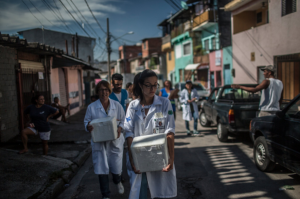On March 20th, Brazil’s government announced that it planned to vaccinate the entire country against another outbreak of yellow fever by April 2019. For those who may not know, yellow fever is a nasty disease. It’s caused by a virus that is spread through mosquito bites. The first time I learned about it was in the seventh grade when my class was studying Colonial American history in Philadelphia. The worst epidemic occurred during the summer of 1793. At the time it started around 100 people died, but at the end, the death toll reached 5,000. While modern medicine has come a long way since 1793, yellow fever is not to be taken lightly, further evidenced by the fact that in this year alone 300 people (including tourists) in Brazil have already died from the virus. “This virus has hit the outlying areas of the country’s largest cities, Rio de Janeiro and São Paulo, particularly hard, threatening to become (Brazil’s) first-blown urban epidemic since 1942.” (

Fever 1793 by Laurie Halse Anderson
Despite the disease’s normal location in Amazon River basin, it broke out of its usual pattern in early 2016 and started to move toward the country’s largest cities, which prompted the declaration of a public health emergency in 2017. Perhaps what is more troubling than the outbreak of the disease, is the number of domestic people who still need vaccinations. At a news conference, Health Minister Ricardo Barros said, “We are going to act preventively instead of reacting with emergency measures as we have done.” Referring to the fact that health officials would need to vaccinate an additional 77.5 million people to reach the country’s entire population by April of next year.
Ironically, critics say health officials are the ones who failed to act aggressively, due to the fact that they determined yellow fever had limited reach and was therefore not worth the risk of vaccinating the entire population. These actions or lack thereof subsequently left them scrambling when the virus appeared near São Paulo in the most recent outbreak. Additionally, increasing efforts to vaccinate 23 million people this year have been hampered by “false rumors” about the vaccine.
Historically, it is hard to conceptualize the recent events going on in Brazil. While we have talked about shifty politics and dictatorship in class, I’m not sure this current epidemic falls directly under those categories. I think that if one wanted to, they could make the argument that the governments’ ineptitude in handling the yellow fever outbreak could possibly fall under state-sanctioned violence. I myself am not making that argument because I feel like I would need to do more research, but judging from the tone of this article, I feel like it could be made. I also feel like this argument might hold credence due to the fact that Brazil just came off from dealing with the massive Zika virus outbreak that spread from 2015-16.

Health workers visited the Pirituba neighborhood of São Paulo this month to vaccinate residents. Credit Dado Galdieri for The New York Times
